Juror: James Surls
Curator: Terry Suhre
On behalf of An Appalachian Summer, the Office of Cultural Affairs, and the Catherine Smith Gallery I want to express our gratitude to all of the artists who participated in this year’s competition and congratulate those selected for the exhibition. We appreciate their efforts in making these works available to our community during the upcoming year. I wish to offer our sincerest thanks to our juror, James Surls, for accepting the difficult challenge of adjudicating this year’s competition and commend him for selecting these outstanding works.
A generous annual gift from Martin and Doris Rosen makes the sculpture competition possible. Mr. and Mrs. Rosen continue to be a major force contributing to the cultural climate of the University and Northwest North Carolina. We are most grateful for their support and wish to extend our deepest appreciation.
On view year round, the Rosen Outdoor Sculpture Competition and Exhibition is recognized as a dynamic component of the visual arts not only for Appalachian State University but throughout the Southeast.
-Terry Suhre, Curator
Juror’s statement
Art – what a challenge! What does it mean? What does it say? What is it symbolic of? What does it represent? Why should we look and listen when we are in its presence? Before I start to work on any piece of art I ask myself these questions. I want my art to have meaning; to say something; to be symbolic and represent something of me. My art is a slice of my being. It is about what I refer to as “human phenomenon.” I assume that what is important and profound to me, also has meaning and importance to others. Within the art lies the answers. Art will not lie, it will only tell you the truth.
-James Surls
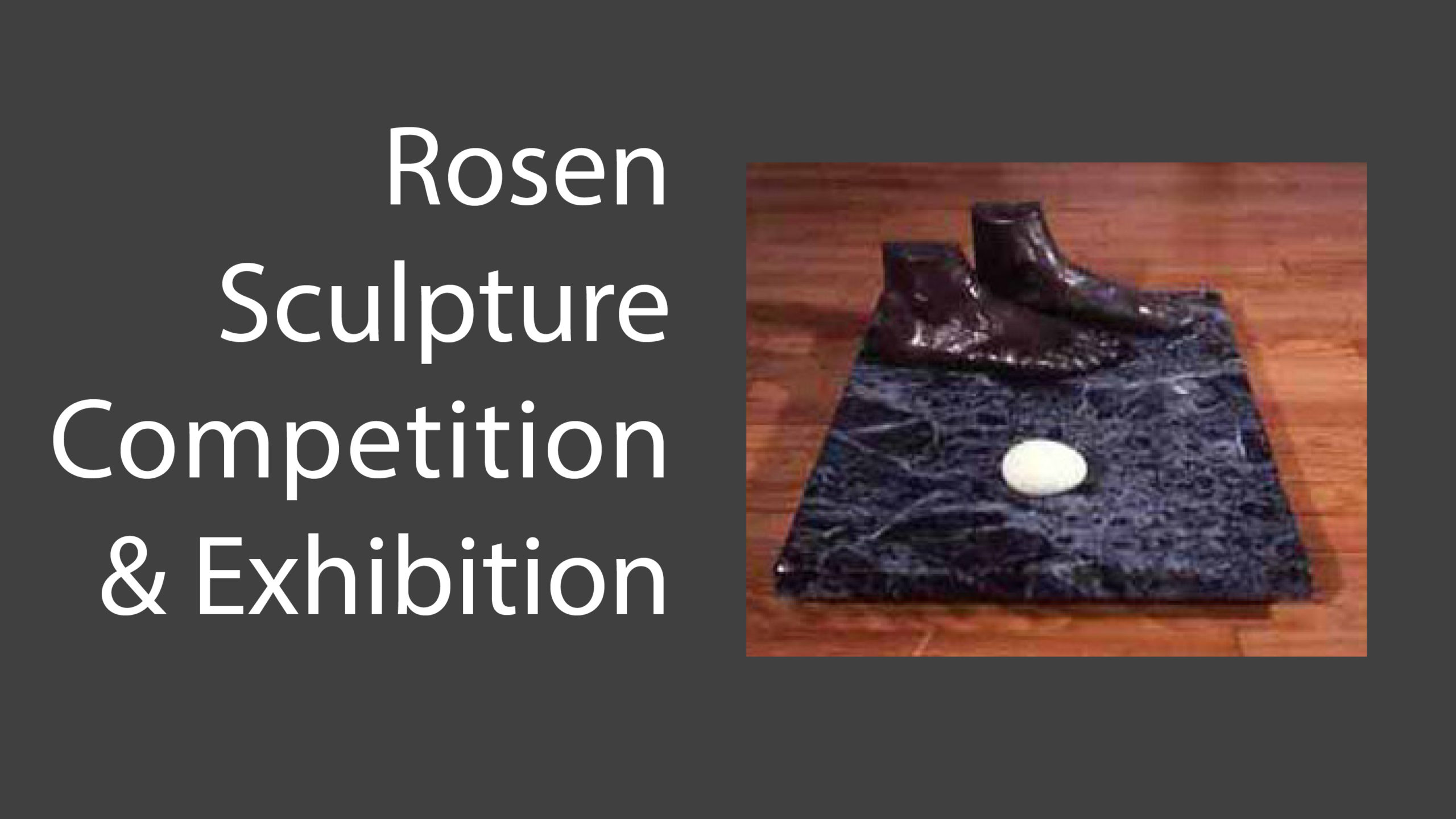
Mary Seyfarth, Self Kore. 1995 / 9th Rosen Sculpture Competition Winner.
Sculptures
-
Self Kore1st Place
Self Kore
Mary Seyfarth
Highland Park, Illinois
Bronze, Clay, and Marble. 7″ x 2′ x 1′ 4″
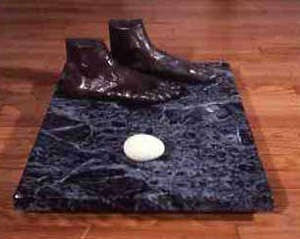
Artist statement
Self Kore is one of two sculptures using my feet that I completed after trips in 1987 and 1990 to Greece when I worked on an archeological excavation at “Synaxis,” a Roman, Early Christian, and Byzantine site in northern Greece.
On my first trip, I had seen in a museum a pair of stylized footprints, which were carved into a thick marble slab. Their simplicity was impressive, and it was evocative of presence. The carving was so elementary it seemed modern! Yet, the carving and the fragment were 800 years old.
The “Kore,” female, and the “Kouros,” male, are the free standing archaic Greek figures in a frontal position with the left foot slightly advanced of the right. All that remains today of most of the ancient Greek sculptures are fragments, and the visitor can only see, or appreciate, or even judge the whole body by broken and isolated parts.
Paradoxocally today, in our Post-Modern world, fragments of the whole are the objective. A complete style or philosophy is represented by fragments or “parts of…” My feet are counterpoised with an egg. The egg is the third element in the composition; it is often a form in a “still-life;” it a feminine form and the egg has a beautiful, natural, and mysterious whiteness to it.
Bridge Bed
Jennifer Hecker
Brockport, New York
Steel, Crushed Charcoal, Brick, and Wood. 6′ 10″ x 2′ 8″ x 6′ 6″
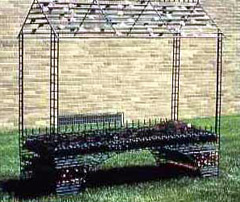
Artist statement
For the past four years or so, my work has been inspired by objects of prayer from different cultures and belief systems. These works have ranged in size from relatively large, outdoor works to hand-held objects. The materials used in their construction have varied as well.
Bridge Bed is about cremation, funeral pyres, burning bridges, and the burning of leaves in Autumn – the end of the life cycle.
About the artist
Jennifer Hecker has an extensive and diverse exhibition record that includes solo shows, commissions, collaborative installations, public art projects, outdoor sculpture shows, adjudicated exhibitions, and permanent collections. Recent exhibitions include: “The Next: A Studio Glass Movement Continuum” at Tower Fine Arts Gallery in Brockport, NY (2015); “Taos Art Glass Invitational” at David Anthony Fine Art in Taos, NM (2014); 4th Biennial Western Cast Iron Art Exhibition at University of Wyoming in Laramie (2014); and “Water: A Universal Human Right,” at the State Street Gallery in Chicago, organized by the Chicago Women’s Caucus for Art (2014). In 2013, Jennifer was one of 42 regional artists invited to create a new work inspired by an artwork in the permanent collection of the Memorial Art Gallery in Rochester, NY in celebration of its centennial. In 2011, Jennifer was one of 30 artists from around the world to be featured in the book Sculpture and Design With Recycled Glass by Cindy Ann Coldiron (Schiffer Publishing). Jennifer’s sculptures were twice selected for inclusion in the prestigious Rosen National Outdoor Sculpture Exhibition at Appalachian State University in Boone, North Carolina (1996 & 2011). In 2006, her commissioned outdoor sculpture for the Village of Brockport, Les Racines et les Raisons (The Roots and the Reasons) was dedicated in Remembrance Park. In 2004, she completed a significant commission for a three-part, site-specific sculpture for Christ Church in Pittsford, New York. Her work is included in the permanent collections of The Red Cross in Rochester, NY; The Children’s Inn at the National Institute of Health in Bethesda, MD, and SUNY College at Brockport, as well as private collections in New York, Virginia, Illinois, Florida, and Minnesota.
Jennifer Hecker is a professor in the Department of Art at The College at Brockport, where she has taught all levels of sculpture, as well as general education art courses since 1989. In 1999, she was awarded a Chancellor’s Award for Excellence in Teaching, and in 2002 she completed a 6-year term as department chairperson. Jennifer received her MFA in Sculpture from the University of Minnesota in 1984, and her BFA in Sculpture with honors from the University of Illinois in 1980.
For more information, visit jenniferhecker.net.
Endless Spur
Zdeno Mayercak
Brooklyn, New York
Wood. 13′ 6″ x 4′ x 4′ / 14′ x 4′ x 4′
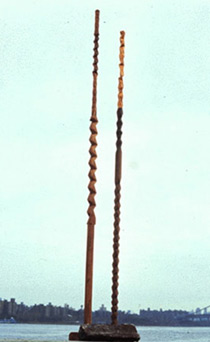
Artist statement
For the last fourteen years, I have been working predominantly in wood, believing in the potentials of this classical natural material. I started to investigate the motif of a column in 1982. For me, these columns are a symbolic search for the spirituality – a connection between an infinite space and earth. I believe that they are helping me to define my own spiritual nature.
Floating Carpet
Maryrose Carroll
Vilas, North Carolina
Aluminum and Wood. 6′ x 6′ x 7′
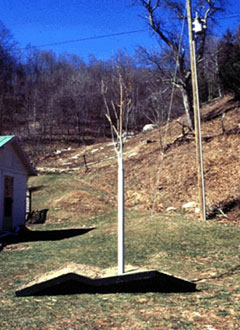
Artist statement
A sculpture is a visible dream. We hope it awakens the beautiful dreamer among us.
About the artist
Education: BFA, University of Illinois; MA, Illinois State University.
Framework
Charlie Brouwer
Willis, Viginia
Aluminum. 8′ x 8′ x 4′
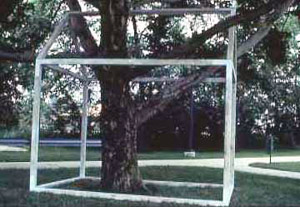
About the artist
Education: BFA, University of Illinois; MA, Illinois State University.
Planting and Plowing in Bosnia
Jim Buonaccorsi
Watkinsville, Georgia
Steel and Corn. 5′ x 4′ x 7′ 6″
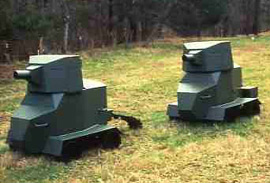
Artist statement
My work addresses social, political, and philosophical issues. The sculpture I make is not an attempt at moralizing, prophesying, or passing judgment, but rather a way of confronting the issues we conveniently ignore. The majority of my work is large-scale, outdoor sculpture which is exhibited in public situations. Most of the works are constructed in steel with other media, such as bronze, glass, and concrete included in the pieces. My sculpture is industrial, both in appearance, as well as the method of construction. I feel that this type of industrial imagery successfully addresses the post-industrial, post-war, socio-political, and philosophical issues I want to call into question. The utilization of the industrial image also acts as an indicator of time and place. Although as a species we continue to make claims of great progress in both civilization and technology, this progress is often misused. The same mistakes are constantly being made and our technology, which is most often war generated, has merely made us more efficient in making these mistakes.
About the artist
Born 1957, Providence, Rhode Island
B.A. Rhode Island College, 1982
M.F.A. Cranbrook Academy of Art, 1984
Associate Professor, University of Georgia, Athens, Georgia
Jim Buonaccorsi’s work has been included in over one hundred and fifty exhibitions, including solo exhibitions at City Gallery Chastain in Atlanta, Georgia, 621 Gallery in Tallahassee, Florida, Fugitive Art Center in Nashville, Tennessee and Marshall Arts in Memphis, Tennessee. His most recent solo exhibition was held at The Flood Fine Art Center in Asheville, North Carolina in 2008. His work has received numerous awards including the Reese Collection Annual Purchase Award at the University of Tennessee and The Martin and Doris Rosen Award at the Rosen Outdoor Sculpture Competition, Appalachian State University, Boone, North Carolina. He has also received a Georgia State Council for the Arts Individual Artist Grant and the M.G. Michael Award for outstanding research and two Senior Faculty research grant at the University of Georgia. His work is in numerous public and private collections. Jim and his wife, LeeAnn Mitchell, also a sculptor, live and run their studios in Farmington, Georgia.
For more information, visit www.metaletal.com.
Seeds of Memory
Ava Blitz
Byrn Mawr, Pennsylvania
Cast Concrete. 3′ 8″ x 1′ 8″ x 2′
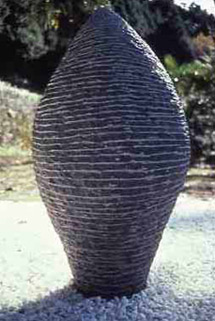
Artist statement
From an early age, I have carved heads that were reminiscent of and influenced by many cultures: Egyptian, African, Pre-Columbian, etc. I have worked in stone and feel that I, like artists in all cultures, have a basic human desire to represent and eternalize myself and my collective life in a permanent and symbolic fashion. There is a formal similarity and simplicity inherent in this action that seems to be universal. Over time, my work has become increasingly less literal, more abstract, and for now more organic. Symbols of plant, animal, and utilitarian forms such as shells, hives, leaves, flowers, and vessels, have replaced the actual figure. The symbols are life-giving, often female, nourishing, sheltering, soft yet cast or carved in hard stone, long-lasting but simultaneously defining growth, change, and evolution. In the natural cycle of things, death accompanies life. The idea of fossils and artifacts, a memory of the past, also appears in my work. I try to create beautiful, contemplative, spiritual objects, informed by the past and by cultural tradition. Their particular presentation or installation in indoor or outdoor environments extends their meaning. I am attracted to natural materials that harmonize with the environment, such as stone and concrete, itself an aggregate of sand and stone. I am interested in the inherent possibilities of materials, and the artist’s involvement with the sculptural process itself.
Untitled
Marcia Kaplan
Chicago, Illinois
Poly Resin, Cloth, and Gut. 4′ x 4′ x 4′
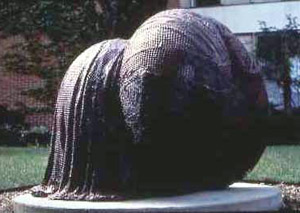
Artist statement
I usually do not issue written statements regarding the nature of my work. The work must speak for itself. The forms and materials are my vocabulary, therefore the work must be considered or judged by the visual materials that I send out. I am a visual artist, I am not a writer. I realize I have been involved from the early work, in making dwellings using basically skins of one kind or another to build my structures. The forms are from myself, about myself, but existing in nature and in my environment. I attempt to make what I know and imagine.
Untitled
Stephen Montague
Columbus, Ohio
Lead. 5″ x 6′ x 6′
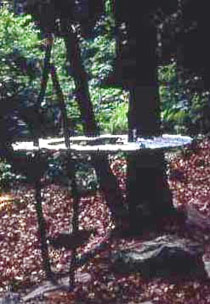
Artist statement
This work was designed primarily for a grove of trees near a creek bed. I poured lead around the trees, suspending the lead above the ground like a frozen stream, reminiscent of the flooding water. The use of lead represents what we have poured into the creek and other bodies of water, and the flood of toxins with which we live.
I wish to thank Edward Lead Manufacturing, Columbus, Ohio; Ace Iron and Metal Company, Columbus, Ohio; and Tom Alspach.
View
Michael Warrick
Little Rock, Arkansas
Bronze and Steel. 14′ x 7′ x 3′
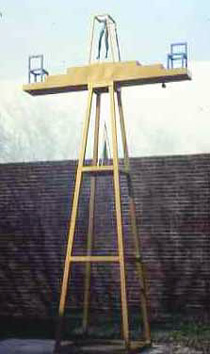
Artist statement
View is based on personal experience and an awareness of political, social, and domestic situations in which people have been removed or removed themselves from contact with society.
View is the portrait of an individual who is physically and psychologically seperated from society. In this instance, the paranoid behavior and sparse human interactions that the individual is displaying are the result of Alzheimer’s disease.
About the juror
James Surls, is a nationally known artist who has been creating sculptural works from wood for nearly two decades. Surls began his work in wood, creating large animalistic sculptures carved by chain saw from tree trunks and embellished with other natural materials. His early works have been compared to African and Egyptian art and prehistoric Indian pictographs.
The artist was raised on a farm in East Texas and grew up learning how to use his father’s carpentry tools – the axes and hand saws that were to later become his tools as a sculptor. He earned a bachelor’s degree in art from Sam Houston State University in Huntsville, Texas, and a master of fine arts degree at the Cranbrook Academy of Art in Bloomfield Hills, Michigan. Mr. Surls taught sculpture at the University of Houston from 1976 to 1982. He received his first public commission in 1977 for a public building in New Bedford, Massachusetts. The sculpture Seaflowerwas referred to as a “frightened caterpillar” and “crippled sea urchin” in unfavorable public commentary. But the piece caught the eye of Newsweek magazine, which hailed it for “challenging the prevailing architecture with its natural wood.” In a 1987 review in ARTnews, Surls’ one man show at the Allen Frumkin Gallery in New York City was praised for providing “one of those much needed intrusions on New York insularity.” The Dallas Museum of Art organized a one-man exhibition of Surls’ work in 1987. His sculpture also is in the permanent collections of the Solomon R. Guggenheim Museum, the Los Angeles County Museum of Art, the Museum of Modern Art, the Milwaukee Museum of Art, and the Whitney Museum of American Art.
A Special Thanks from the Curator
I want to take this opportunity to thank my colleagues in the Office of Cultural Affairs; Perry Mixter, Director; Gil Morgenstern, Artistic Director for An Appalachian Summer; Sali Gill-Johnson, General Manger; Sara Heustess, Box Office Manager for Farthing Auditorium; Greg Williams, Technical Director for Farthing Auditorium; Jim Sigmon, Assistant Technical Director for Farthing Auditorium; Denise Weissberg, Director of Marketing and Public Relations; Elizabeth Loflin, Assistant Director of Marketing and Public Relations; and Sandra Black, Fiscal Officer. I also wish to acknowledge the support of Dr. Jim Hutchens, Chair of the Department of Art; Dr. Clyde Robbins, Assistant Vice-Chancellor for Physical Plant Operations; Larry Bordeaux, Director of Facility Support Services; Douglas Canipe, Plant Maintenance Supervisor; Jim Bryan Grounds Supervisor; Evan Row, Safety Officer; and Glen Phiffer, Professor of Art. I greatly appreciate their advice and encouragement.
My thanks to those whose skills and talents made this publication possible, including Ed Midgett for providing yet another excellent design for this exhibition catalogue, and Hank T. Foreman, for his many contributions in the realization of this program. I am grateful to the summer gallery interns, Allison Lyons, Rebecca Copeland, Ashley Long, Stacey Halsey, and Trina McGlamery for their hard work and valuable assistance in the installation of these works on our campus.
To all of the above I extend my sincerest gratitude.
-Terry Suhre
